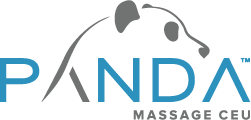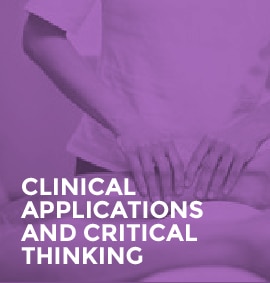Therapeutic work can be an intense experience for both the therapist and the client. There are physical, mental, and emotional components involved throughout each session. This is especially true when working with a client that has chronic dysfunction.While enrolled in this course of study, you will learn to:
- Categorize techniques into proper protocol phases for successful outcomes
- Utilize critical thinking skills when performing clinical protocols
- Recognize postural muscles and their movements
- Identify postural and functional dysfunctional patterns
- Address common dysfunctions using basic clinical protocols
- Design, evaluate, and revise appropriate treatment plans
And with our Clinical Applications Massage CEU course, it’s readily available to practitioners like you.
If you’ve been in search of clinical applications training, look no further than this comprehensive online course from Panda Massage CEU™.
Learning Objectives for Our Clinical Applications and Critical Thinking in Massage Therapy CEU Course

First, by examining a list of this class’s learning objectives, you’ll understand what you can expect to gain from participating in this course. And, secondly–and perhaps even more importantly–you stand to gain as an adult learner. When taking on new information as an adult, there are both disadvantages to be overcome (maybe it’s been awhile since you’ve been in school) as well as advantages to be harnessed (you’re motivated, focused, and probably more interested in the content than the average college student). As a result of preparing you for what the course will cover, reading through the learning objectives will help to increase your level of retention throughout the course and aid in making your learning more effective and efficient.
In layman’s terms, our continuing education course will cover the history of the technique, its benefits, various contraindications, and an effective sequence of techniques for you to use in your massage practice.
That said, let’s go into more detail. After completing this course, you’ll be able to accomplish the following:
Categorize Techniques into Proper Protocol Phases for Successful Outcomes
- Assessment & Testing
- Initial Contact
- General Warming
- Specific Warming
- Specific Treatment
- Muscle Lengthening
- Reassessment/Retesting
- Transition/Conclusion
- Building the Treatment Plan
Clinical Protocols differ over relaxation protocols due to bench marks that must be met and recorded in order to chart client progress throughout each session. Clinical massage serves a purpose through meeting goals which improve specific compensatory patterns and dysfunctions. Clinical Massage requires critical thinking in order to determine where dysfunctional soft tissue patterns are located and what is involved or required to address the areas effectively. Critical Thinking skills are also required to determine effective treatment plans which may include several technique variations or combinations that will help the client improve.
Recognize Postural Muscles and Their Movements
Structural assessment and postural analysis includes techniques that will identify both postural and functional distortions as well as soft tissue compensatory patterns such as myofascial shortening and muscle tension or decreased range of motion. Observation and palpation includes visual and palpation findings such as structural alignment, tissue bruising, scaring, edema, vein conditions, muscle development symmetry, soft tissue pliability and flexibility provide possible clues towards dysfunction etiology and effective treatment.
What are CEUs, and Why are They Important?
Your continuing education as a massage professional involves two important components. On the one hand, your daily experience in the clinic provides you with a practical education that’s an absolute necessity to your professional growth. At the same time, however, it’s equally essential to continue your education in a more traditional way. If you’re wondering how you can do that, we’re here to help. Massage CEUs, or Continuing Education Units (GUIDE TO LMT CONTINUING EDUCATION), are an excellent way to keep learning long after you’ve graduated from a massage program.
And while massage CEUs are a huge part of professional development, they’re also often a legal requirement. In most states, all licensed practitioners are required to take a certain number of CEU hours (NCBTMB GUIDE) each year (or sometimes every two to three years) in order to keep their license current.
As an NCBTMB Approved Provider of CEUs, Panda Massage CEU can provide you with quality education that fulfills state and national requirements.
Why Choose Panda Massage CEU?
There may be other online providers of massage CEU courses, but we’re confident that Panda Massage CEU is the best choice for your continuing education needs:
Quality
Other courses are of questionable quality. Meanwhile, we’re proud to offer some of the best massage CEU courses in the country, and stand by our quality 100%.
Unique Topics
We offer required courses like medical errors, which many states mandate that you take. But we also have exciting courses with unique topics such as deep tissue, hydrotherapy, and more.
Professional Narration
Some online courses are poorly made, with low quality audio. Our courses are professionally narrated, and of the highest caliber.
Self-Paced
Sometimes, your busy schedule can interfere with your ability to obtain CEUs. We understand this, and that’s why all of our courses are self-paced. No matter how hectic your schedule gets, you’ll be able to keep up with the material.
Great Prices
Our courses aren’t just high quality: they’re also an amazing value. Our affordable prices mean that our CEU courses work with any budget. And remember: online courses can save you thousands of dollars that you’d spend on travel while attending an in-person course.


There are no reviews yet.